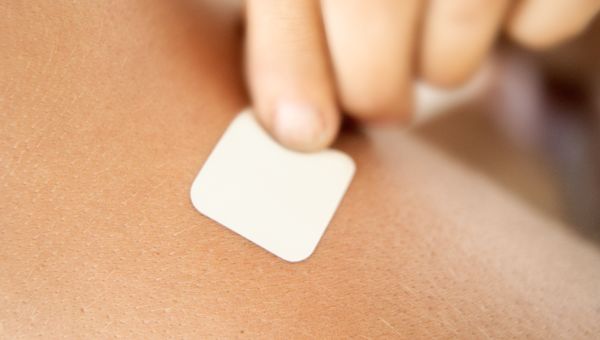A guide to nicotine replacement therapy (NRT)
Learn about the patches, gums, lozenges, and nasal sprays that help people who smoke quit nicotine.
Updated on February 6, 2024

Nearly 70 percent of people who smoke say they want to stop, according to the Centers for Disease Control and Prevention (CDC). Quitting smoking can help to lower the risk of many serious health conditions. This includes heart disease, many types of cancer, and chronic obstructive pulmonary disease (COPD).
Kicking the habit is not easy. But there are tools available to… Show More
Nearly 70 percent of people who smoke say they want to stop, according to the Centers for Disease Control and Prevention (CDC). Quitting smoking can help to lower the risk of many serious health conditions. This includes heart disease, many types of cancer, and chronic obstructive pulmonary disease (COPD).
Kicking the habit is not easy. But there are tools available to help, such as medications, counseling, and self-help materials. Many people have found success through nicotine replacement therapy (NRT), too. NRT eases withdrawal symptoms and cravings caused by the loss of nicotine from cigarettes. It comes in several different forms.
Could NRT could help you or someone you love quit smoking? Here’s the lowdown on four forms of NRT approved by the U.S. Food and Drug Administration (FDA).
Show Less
Nicotine Patch
A nicotine patch releases nicotine into the body through the skin. Every 24 hours, a new one should be placed above the waist, on clean, dry skin with no hair, irritation, or damage. The shoulders, back, upper chest, or arm above the elbow are common spots.
The patch is available in several… Show More
A nicotine patch releases nicotine into the body through the skin. Every 24 hours, a new one should be placed above the waist, on clean, dry skin with no hair, irritation, or damage. The shoulders, back, upper chest, or arm above the elbow are common spots.
The patch is available in several strengths. This is so you can wean off nicotine gradually. Someone who smoked a pack a day (20 cigarettes) would start with a full-strength patch (21 milligrams of nicotine per day). Over time, they would switch to lower doses, such as 14 mg or 7 mg. Someone who smoked less may begin at a lower dose. The ultimate aim is to stop using the patch altogether.
The Pros: Different nicotine patches allow you to choose the best one for your habit. By working down the levels, you can gradually cut down on the amount of nicotine you take in. Ideally, you won’t need any nicotine by the time treatment is over.
The Cons:
- A patch may not be right for people with sensitive skin.
- Since the nicotine patch slowly releases nicotine into the bloodstream, the level of nicotine can't be adjusted. If you have a strong nicotine craving, you may need extra help, like a piece of nicotine gum or lozenge.
- Unlike a gum or lozenges, a patch does not address certain parts of psychological addiction. This includes the need to do something with your hands or mouth.
Side Effects: Possible side effects include:
- Skin irritation at the site of the patch
- Sleep problems, including vivid dreams
- Headaches
Side effects vary depending on:
- The dose of nicotine
- The person's skin sensitivity
- How long the patch is used
- How it's applied
People who are exposed to a lot of nicotine may develop other symptoms. These can include dizziness, nausea and vomiting, and a racing heartbeat.
Show Less
Nicotine Gum
This special chewing gum gets nicotine to the bloodstream through the lining of the mouth. You chew it slowly until it's soft and gives off a tingly feeling and/or peppery taste. Then, you press is between your cheek and gums, known as "parking." When the tingling sensation stops, you chew it again… Show More
This special chewing gum gets nicotine to the bloodstream through the lining of the mouth. You chew it slowly until it's soft and gives off a tingly feeling and/or peppery taste. Then, you press is between your cheek and gums, known as "parking." When the tingling sensation stops, you chew it again and park it in a different place in your mouth. This process is continued until the gum runs out of nicotine (about 30 minutes).
Nicotine gum is available over the counter, in doses of 2 mg and 4 mg. If you smoke within 30 minutes of waking up, you may need to start with the higher 4 mg dose. Nicotine gum is usually recommended for 6 to 12 weeks. Some people may benefit from using it longer. People who use it for a very long time should talk to a healthcare provider (HCP).
The Pros: Since nicotine is absorbed through the mouth, it gets into the blood more quickly than it would with a patch. It may also be a better choice for people who have sensitive skin.
Gum also allows people to control the nicotine doses their bodies receive. It can be chewed as needed, on a schedule, or every one to two hours during the day. No more than 24 pieces of gum are recommended per day. Over time, you can lower your dose—or how often you chew the gum—until you stop using it entirely.
The Cons: The gum can damage dentures and dental prostheses. You cannot eat or drink 15 minutes before using the gum or while using it. And while it is not common, long-term dependence is possible.
Side Effects: These include:
- A bad taste in the mouth
- Throat irritation
- Mouth sores
- Hiccups
- Nausea
- Jaw discomfort
Symptoms related to the stomach and jaw are usually caused by improper use. This includes swallowing nicotine or chewing too fast.
Show Less
Nicotine Lozenges
Smoking-cessation lozenges and mini-lozenges release nicotine as they slowly dissolve in the mouth.
It’s recommended you use no more than 20 lozenges per day or more than five lozenges in six hours. After a time—often between 8 to 12 weeks—you can use fewer and fewer lozenges until you are… Show More
Smoking-cessation lozenges and mini-lozenges release nicotine as they slowly dissolve in the mouth.
It’s recommended you use no more than 20 lozenges per day or more than five lozenges in six hours. After a time—often between 8 to 12 weeks—you can use fewer and fewer lozenges until you are completely nicotine-free.
You can choose your dose based on when you smoke your first cigarette in the morning. People who smoke within 30 minutes of waking up usually use the 4 mg dose. If you use the lozenge and nicotine patch at the same time, consider starting at the 2 mg dose.
The Pros: Since nicotine is absorbed through the lining of the mouth (like gum), it gets into the blood faster than patches. It also reaches the brain faster, sending the message that your body has enough nicotine.
The Cons: You cannot eat or drink 15 minutes before using the lozenge or while using it. Biting or chewing the lozenge or tablet can lead to too much nicotine being swallowed quickly. This can cause indigestion or heartburn.
Side Effects: Possible side effects include:
- Nausea
- Hiccups
- Coughing
- Heartburn
- Headache
- Gas
- Trouble sleeping

Nicotine Nasal Spray
The nasal spray quickly delivers nicotine to the bloodstream since it's absorbed through the nose. It is available only by prescription.
The Pros: It relieves withdrawal symptoms very quickly. It also helps you control nicotine cravings.
The Cons: Because you control how much spray you use, you… Show More
The nasal spray quickly delivers nicotine to the bloodstream since it's absorbed through the nose. It is available only by prescription.
The Pros: It relieves withdrawal symptoms very quickly. It also helps you control nicotine cravings.
The Cons: Because you control how much spray you use, you could potentially use too much. People with asthma, allergies, nasal polyps, or sinus problems are usually discouraged from using the spray.
Side Effects: The most common include:
- Nasal irritation
- Runny nose
- Watery eyes
- Coughing
- Sneezing
- Throat irritation

The Benefits of Quitting
Quitting smoking is one of the best things you can do for your health. According to reports from the U.S. Surgeon General:
- Two weeks to three months after quitting, your blood flow improves and your lung function increases.
- One year after quitting, your risk of coronary heart disease is half … Show More
Quitting smoking is one of the best things you can do for your health. According to reports from the U.S. Surgeon General:
- Two weeks to three months after quitting, your blood flow improves and your lung function increases.
- One year after quitting, your risk of coronary heart disease is half of someone who smokes.
- Five to fifteen years after quitting, your stroke risk declines to that of someone who does not smoke.
- Ten years after quitting, your risk of many different cancers falls.
- Fifteen years after quitting, your risk of coronary heart disease drops to that of a person who doesn’t smoke.

Centers for Disease Control and Prevention. Smoking & Tobacco Use: Smoking Cessation: Fast Facts. Reviewed March 21, 2022.
Centers for Disease Control and Prevention. Smoking & Tobacco Use: Benefits of Quitting. Reviewed October 25, 2023.
Smokefree.gov. Using Nicotine Replacement Therapy. Accessed January 31, 2024.
Smokefree.gov. Know Your Triggers. Accessed January 31, 2024.
U.S. Food & Drug Administration. Want to Quit Smoking? FDA-Approved and FDA-Cleared Cessation Products Can Help. Current as of July 21, 2022.
MedlinePlus. Nicotine Transdermal Patch. Revised October 15, 2015.
Centers for Disease Control and Prevention. Tips From Former Smokers: How to Use Nicotine Patches. Reviewed September 12, 2023.
American Cancer Society. Nicotine Replacement Therapy to Help You Quit Tobacco. Revised August 2, 2021.
MedlinePlus. Nicotine Gum. Revised October 15, 2017.
Centers for Disease Control and Prevention. Tips From Former Smokers: How to Use Nicotine Gum. Reviewed September 12, 2023.
MedlinePlus. Nicotine Lozenges. Revised January 15, 2022.
Centers for Disease Control and Prevention. Tips From Former Smokers: How to Use Nicotine Lozenges. Reviewed September 12, 2023.
MedlinePlus. Nicotine Nasal Spray. Revised July 15, 2016.
American Lung Association. Benefits of Quitting. Updated May 31, 2023.
More On


video

article

slideshow


video


video
